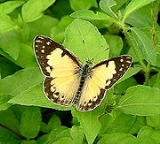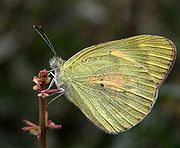
Colotis amata
Encyclopedia
The Small Salmon Arab, Colotis amata is a small butterfly
of the family
Pieridae
, that is, the Yellows and Whites, which is found in Asia
.
Male upperside has a salmon-pink ground colour. The costa on the forewing is black and thickly overlaid with greyish or pinkish scales ; a black spot at apex of cell, which may be large and quadrate or smaller and lunate ; termen broadly black, with an enclosed double transverse series of spots of the ground-colour the inner series consists of a large spot in interspace 1, two very small spots in interspaces 2 and 3, one in.each, and four larger anterior spots placed in a curve ; the spots in the outer series are variable in number, but generally there is one in each interspace, these are more or less linear in shape. Hind wing: a band on costal margin extended to just within the upper margin of the cell, covered with dense black specialized scales ; this black band joined on to a broad similarly- coloured terminal band of ordinary scales, that becomes more or less diffuse and powdery posteriorly, and encloses a double series of small spots of the ground-colour the inner series often obsolescent, in some specimens entirely absent; dorsum heavily irrorated with fuscous scales, the irroration extended on to the disc, which has therefore generally a greyish appearance.
 Underside : greenish yellow ; an anticiliary fine black line on both fore and hind wings ; the black markings of the upperside show through by transparency. Fore wing : a black spot, variable in size and intensity, in some specimens absent altogether, at apex of cell ; a subterminal quadrate black spot in interspace 1 and another (sometimes faintly marked or absent) further outwards in interspace 2 ; disc faintly, dorsal margin broadly very pale salmon-pink. Hind wing: the whole surface sparsely irrorated with minute black scales ; a small black discocellular spot. Cilia of both fore and hind wings pale salmon-pink. Antennae, head, thorax and abdomen black, the antennae speckled with white, the head and thorax covered with greenish-fuscous hairs ; beneath : the palpi green, thorax and abdomen white.
Underside : greenish yellow ; an anticiliary fine black line on both fore and hind wings ; the black markings of the upperside show through by transparency. Fore wing : a black spot, variable in size and intensity, in some specimens absent altogether, at apex of cell ; a subterminal quadrate black spot in interspace 1 and another (sometimes faintly marked or absent) further outwards in interspace 2 ; disc faintly, dorsal margin broadly very pale salmon-pink. Hind wing: the whole surface sparsely irrorated with minute black scales ; a small black discocellular spot. Cilia of both fore and hind wings pale salmon-pink. Antennae, head, thorax and abdomen black, the antennae speckled with white, the head and thorax covered with greenish-fuscous hairs ; beneath : the palpi green, thorax and abdomen white.
Female is polymorphic.
Form 1. Upperside : ground-colour paler than in the male , in some specimens quite ochraceous outwardly ; all the markings
similar, but duller in tint. The hind wing, of course, without the black costal band of specialized scales, the ground-colour extended up to the costal margin. Underside similar to that of the male, but the ground-colour very much paler and more ochraceous than green. In some specimens, in addition to the black spots in interspaces 1 and 2 on fore wing, there is an anterior postdiscal fuscous curved band. Hind wing : discocellular spot larger than in the 3 and annular; a curved discal series of reddish spots from costa to dorsum.
Form 2. Similar to female form 1, but the ground-colour pale primrose-yellow to pure white. Antennae, head, thorax and
abdomen in both forms much as in the male.
, cylindrical or slightly depressed with a rough surface due to minute tubercles, from
each of which grows a very small bristle. The colour is a uniform grass-green, with a blue dorsal line more or less distinct, and a
yellowish lateral line dividing the colour of the back from the paler green of the underparts." (Davidson & Aitken quoted in Bingham )
Pupa: "Compressed ; wing-cases produced into a keel like that of Eurema
. It is suspended in the same manner by the tail and a
moderately long band. The colour is usually some shade of dingy whitish brown or dirty green." (Davidson & Aitken quoted in Bingham )
Butterfly
A butterfly is a mainly day-flying insect of the order Lepidoptera, which includes the butterflies and moths. Like other holometabolous insects, the butterfly's life cycle consists of four parts: egg, larva, pupa and adult. Most species are diurnal. Butterflies have large, often brightly coloured...
of the family
Family (biology)
In biological classification, family is* a taxonomic rank. Other well-known ranks are life, domain, kingdom, phylum, class, order, genus, and species, with family fitting between order and genus. As for the other well-known ranks, there is the option of an immediately lower rank, indicated by the...
Pieridae
Pieridae
The Pieridae are a large family of butterflies with about 76 genera containing approximately 1,100 species, mostly from tropical Africa and Asia. Most pierid butterflies are white, yellow or orange in coloration, often with black spots...
, that is, the Yellows and Whites, which is found in Asia
Asia
Asia is the world's largest and most populous continent, located primarily in the eastern and northern hemispheres. It covers 8.7% of the Earth's total surface area and with approximately 3.879 billion people, it hosts 60% of the world's current human population...
.
Description
- See glossaryGlossary of Lepidopteran termsThis glossary describes the terms used in the formal descriptions of insect species, jargon used mostly by professionals or entomologist....
for terms used
Male upperside has a salmon-pink ground colour. The costa on the forewing is black and thickly overlaid with greyish or pinkish scales ; a black spot at apex of cell, which may be large and quadrate or smaller and lunate ; termen broadly black, with an enclosed double transverse series of spots of the ground-colour the inner series consists of a large spot in interspace 1, two very small spots in interspaces 2 and 3, one in.each, and four larger anterior spots placed in a curve ; the spots in the outer series are variable in number, but generally there is one in each interspace, these are more or less linear in shape. Hind wing: a band on costal margin extended to just within the upper margin of the cell, covered with dense black specialized scales ; this black band joined on to a broad similarly- coloured terminal band of ordinary scales, that becomes more or less diffuse and powdery posteriorly, and encloses a double series of small spots of the ground-colour the inner series often obsolescent, in some specimens entirely absent; dorsum heavily irrorated with fuscous scales, the irroration extended on to the disc, which has therefore generally a greyish appearance.

Female is polymorphic.
Form 1. Upperside : ground-colour paler than in the male , in some specimens quite ochraceous outwardly ; all the markings
similar, but duller in tint. The hind wing, of course, without the black costal band of specialized scales, the ground-colour extended up to the costal margin. Underside similar to that of the male, but the ground-colour very much paler and more ochraceous than green. In some specimens, in addition to the black spots in interspaces 1 and 2 on fore wing, there is an anterior postdiscal fuscous curved band. Hind wing : discocellular spot larger than in the 3 and annular; a curved discal series of reddish spots from costa to dorsum.
Form 2. Similar to female form 1, but the ground-colour pale primrose-yellow to pure white. Antennae, head, thorax and
abdomen in both forms much as in the male.
Life history
Larva: "Very like that of EuremaEurema
Eurema is a widespread genus of grass yellow butterflies in the family Pieridae.Species range from Asia, Africa, Australia, and Oceania, to the New World. The type species is the North American Barred Yellow ....
, cylindrical or slightly depressed with a rough surface due to minute tubercles, from
each of which grows a very small bristle. The colour is a uniform grass-green, with a blue dorsal line more or less distinct, and a
yellowish lateral line dividing the colour of the back from the paler green of the underparts." (Davidson & Aitken quoted in Bingham )
Pupa: "Compressed ; wing-cases produced into a keel like that of Eurema
Eurema
Eurema is a widespread genus of grass yellow butterflies in the family Pieridae.Species range from Asia, Africa, Australia, and Oceania, to the New World. The type species is the North American Barred Yellow ....
. It is suspended in the same manner by the tail and a
moderately long band. The colour is usually some shade of dingy whitish brown or dirty green." (Davidson & Aitken quoted in Bingham )
See also
- PieridaePieridaeThe Pieridae are a large family of butterflies with about 76 genera containing approximately 1,100 species, mostly from tropical Africa and Asia. Most pierid butterflies are white, yellow or orange in coloration, often with black spots...
- List of butterflies of India
- List of butterflies of India (Pieridae)

